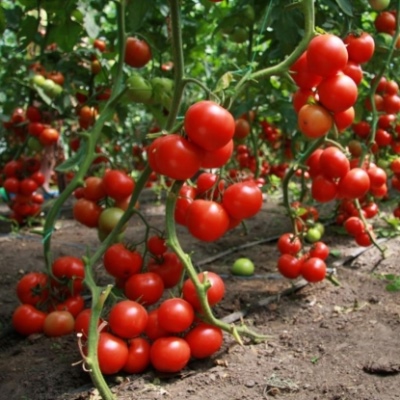
- Authors: Mashtakov A. A., Mashtakova A. Kh., Mashtakov N. A., Mashtakova L. I.
- Year of approval: 2010
- Category: hybrid
- Growth type: determinant
- Appointment: universal
- Ripening period: early
- Ripening time, days: 98
- Growing conditions: for open ground, for film greenhouses
- Marketability: high
- Transportability: good
According to statistics, tomato is almost as popular vegetable as potatoes or cucumbers. It is not surprising that there are a great many varieties of tomatoes. So, the hybrid variety Seven forty has already earned great love and popularity among gardeners due to its excellent characteristics.
Breeding history
Seven forty (another name - Seven forty F1) is a relatively new author's hybrid of the first generation. Belongs to the selection of domestic specialists-agrobiologists Mashtakovs from Rostov-on-Don. Year of approval for use - 2010. The crop is included in the State Register of the Russian Federation for growing in film unheated greenhouses in personal subsidiary plots.
Description of the variety
Seven forty has a determinant type of growth. Leaves are medium in size, green. With simple inflorescences. The popularity of tomato can be explained by its positive qualities:
- pleasant rich taste;
- all ripen at once;
- early ripening dates;
- high heat resistance rates;
- resistant to a large number of diseases;
- good keeping quality of ripe fruits.
The main qualities of the fruit
The tomatoes are flat-round, firm and smooth. As for the color, unripe tomatoes are green, the color of ripe tomatoes is red, bright. There are 6 seed nests inside each fruit, maybe more. Tomatoes are large vegetables, each weighing an average of 235 grams.
Taste characteristics
The taste is defined by many as excellent, pleasant, and a pronounced aroma is also noted. In addition to its taste, the culture has many beneficial properties. Tomatoes of the variety help to reduce blood cholesterol levels. Recommended for use in diseases of the gastrointestinal tract, as they are easily digested, well absorbed.
Ripening and fruiting
The full ripening of the tomatoes of the culture in question will occur on the 98th day after the seeds have sprouted.
Yield
Indicators of marketable yield - more than 15 kilograms per square meter of plantings.
The timing of planting seedlings and planting in the ground
Mainly cultivated using seedling cultivation. Seeds are planted 60 days before transfer to the ground. Seed material is placed in a container with soil mixture at a centimeter depth. Most often, sowing occurs in March or April.

Growing tomato seedlings is an extremely important process, because it largely depends on whether the gardener can harvest at all. All aspects must be taken into account, from seedbed preparation to planting in the ground.
Landing scheme
Seedlings that have grown are planted in the ground, taking into account the density - 3 seedlings per square meter. Scheme - 50 x 50 cm.

Growing and care
When planting, the grown seedlings are buried to 1 leaf, after which the soil is compacted. Plantings should be well watered.
Caring for Seven Forty isn't too different from caring for any other nightshade crop. This is, first of all, timely watering, mandatory loosening of the soil, top dressing and fertilization, as well as weeding from weeds, the prevention of possible diseases through preventive spraying with specialized preparations.
When the bushes are already old enough, they must be tied up to ensure stability. An important part of care is periodic pinching, that is, cutting off the shoots from the lateral parts of the bush. This stimulates the formation of new ovaries.
It is better to provide watering for this crop moderately and only after the next drying out of the surface layer of the earth. A good solution is drip irrigation. Often in agricultural technology, mulching is used with straw, dry leaves - in turn, this will also serve as food for plants. The hybrid responds well to fertilizing with complex fertilizers.




A plant needs different micronutrients at each stage of growth. All fertilizers can be divided into two groups: mineral and organic. Folk remedies are often used: iodine, yeast, bird droppings, eggshells.
It is important to observe the rate and period of feeding. This also applies to folk remedies and organic fertilizers.
Disease and pest resistance
Since Seven Forty is a tomato hybrid, it has excellent immunity. Resistance to such ailments as tobacco mosaic virus (TMV), fusarium wilting, top rot of fruits, alternaria is noted. And also the tomato is resistant to fruit cracking.


Growing regions
The described crop is recommended for cultivation in many areas and regions. The hybrid bears fruit well in the northern and northwestern regions of the Russian Federation, the Central, Volga-Vyatka and Middle Volga regions, in the Central Black Earth Region, as well as in the North Caucasus.

























































































